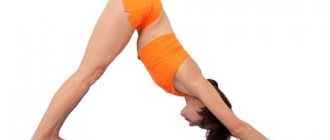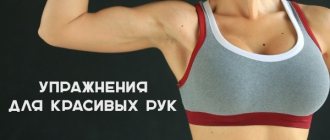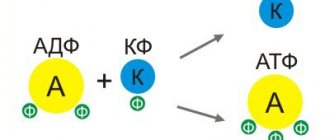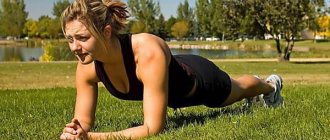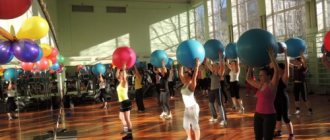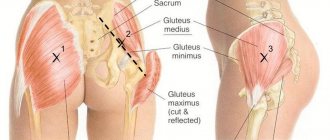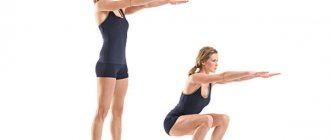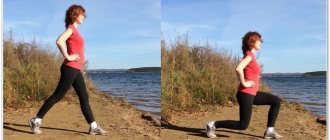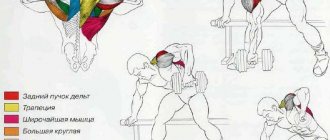How to train the power of a hand strike - setting and developing a strike
What is impact force and what does it depend on?
What is impact force and what does it depend on? Force is mass times acceleration. It follows from this that to increase the power of the blow, both the speed with which you perform the blow and the muscle mass of the arm and the whole body as a whole are important. Among other things, there must be rigidity in the blow, because you are going to hit with your fist? and not slap?
Therefore, if you want to throw a knockout or just a powerful blow, you need to train both the speed of the blow and the muscles involved in the blow - legs, arms, chest, back, shoulders, and it will also not be amiss to develop the correct technique for striking.
What muscles are involved when punching?
When throwing a punch, be it the notorious jab or everyone's favorite hook, the following muscles are involved:
The blow starts from the foot and the energy subsequently passes through the body from bottom to top and reaches the hand:
|
Muscles involved when striking with a hand - their role and importance
Leg muscles and strength
Leg muscles include the quadriceps and calf muscles. The development of these muscles is essential for anyone who wants to have a strong punch. The leg muscles are responsible for pushing off the ground, which fills your body with energy. The leg muscles also happen to be the largest muscles in your body, which is why all punches in boxing tend to involve the legs with a duck, twist and turn.
The greatest power is concentrated in the legs! Not in the chest muscles and not in the triceps. After taking a closer look at many of the most prominent punchers, researchers found that they had well-developed legs, rather than big arms or powerful chests. When studying muscle development in boxers, you won't see huge pecs or triceps. Although large muscles also provide a certain advantage - greater body mass means a more powerful blow.
Gennady Golovkin, Miguel Cotto, Sergey Kovalev are just a few of the people who immediately come to mind. These knockout boxers don't have huge muscles, but the power hidden in their fists is great.
Hips (lower body and balance)
The hips stabilize the lower body and legs. When striking with the hand, they also produce a huge amount of muscular effort by rotating and fixing the body. Because your hips are close to your body's center of gravity, stronger hips mean you have better balance. The ability to maintain balance is one of the most important factors in combat. In reality, balance largely determines the effectiveness and efficiency of your attack, defense, movement and overall ability to fight.
Using your leg muscles, you make a powerful forward movement in the direction of the punch, moving your hips with each punch, and thereby putting your entire body weight into each punch, making it as powerful as possible.
Abs (front part of the body - abdominal muscles)
The abdominal muscles form a very powerful set of muscles that hold your body together. The press allows you to harness the force generated by all your limbs into one powerful and crushing blow.
Back (back of the body - tilt when striking)
The role of the back muscles is also to hold your body together and combine the muscular forces produced by the individual limbs. Also, the back muscles are involved in twisting when striking - thereby strengthening the blow. The back muscles hold the body when the fist collides with the impact surface, thereby preventing the force of the blow from being reduced by bending backwards.
Shoulders (arm endurance)
Shoulders are very important for sustained punching. The shoulders also produce the muscular forces necessary for forward movement when striking with the hand. As a rule, when a boxer's arms are too tired to throw punches or maintain head protection, the reason lies precisely in tired shoulders.
From a physiological point of view, the shoulder muscles support the weight of the entire arm. If you want to throw more punches than your opponent and be able to keep your hands in place for a longer period of time, it is imperative to train your shoulder muscle endurance. You should not strive to make your shoulders as stronger and larger as possible - the contribution they make to the impact force is much less compared to the contribution of the work of your legs.
Arms (power and speed)
It is the hands that are responsible for the force of the blows. The most important function of the hands when striking is to transfer the produced muscular efforts to the enemy through a blow with the hand. The arm itself is only partially responsible for creating muscular forces - and most of this is occupied by the legs and back - the lower back muscles. The main function of the hands is to transfer the forces collected by your body to your opponent in the form of a blow!
Thus, the main function of the arms is to reach forward and touch the opponent. The hands produce the blow, not the force of the blow. Next you will see how important it is to have fast rather than powerful hands. Quick arm extensions provide speed of impact. Speed allows you to unnoticed by the enemy to bypass his defense. And bending your arms at the elbow ensures a quick transition to defense after an attack.
The triceps provide the speed of straight punches. The biceps are responsible for the speed and extension of the arms during hooks and uppercuts. Don’t get carried away with pumping up your arms by making them massive; better make them hard and fast, then you can perform quick combinations of hard punches. The lower body creates the force of the blow, and the hands are its mediator!
Pectoral muscles
Their most important functions are to connect the muscles of the shoulders and arms into a single system. In addition, they provide the greatest contribution to impact force of any muscle in the upper body.
Small muscles
The neck muscles serve to defend against enemy strikes. Many fighters strengthen their neck muscles to prevent their head from flopping around after blows. The muscles of the forearm are responsible for clenching the palm into a fist. A stronger fist means a harder punch. At the same time, a strong fist means you are less likely to get injured in your hand because the bones are fixed and there is not enough room for them to move.
Strength development
The blow must be powerful and sharp. We need to work comprehensively to achieve this goal. You can act both in the hall and at home.
They are implemented in push-ups, pull-ups and squats, and working with apparatus. The optimal load is selected and a schedule and training plan is drawn up. Follow it strictly.
Some of them were reflected above: push-ups with complications, exercises with a bar and a ball. The following activities are also required:
- Pull-ups. They occur on the horizontal bar at home, in the gym or in the fresh air. This is a universal and quite accessible way to develop strength that should not be ignored. The task is to push the maximum and increase it with each workout. For your first session, use your own target, such as 10 pull-ups. And repeat it in two approaches. In the next workout, increase the number of repetitions to 12. Secure it with two circles. Gradually increase the load and vary the exercise. For example, you can do pull-ups at different paces, the first 4 times slowly, then the same number - quickly and even faster. To achieve better condition, you can work with weights on your legs.
It should be borne in mind that the results of this work appear slowly and you should not chase them by immediately setting an unbearable load.
- Work on uneven bars. These are legendary exercises for strengthening your punch. They are included in the training complexes of many combat disciplines. The reason lies in the fact that the main load falls on the arms, and strength is developed effectively. These classes are performed in the classic version and with variations. In the first case, simple approaches and repetitions are performed, for example, 3 and 12, respectively. In the second, the load is increased by adding weights to the legs, changing the tempo of work and some acrobatic sketches. For example, for every 10 times you need to do a somersault on the uneven bars.
- Kettlebell exercises. They powerfully pump the deltoid muscles involved in the attack. Projectiles weighing up to 24 kg are used. Beginners can work with products up to 12 kg. To achieve an effective result, the projectile rises forward, upward, and is lifted cleanly and lifted from a sitting position.
To lift the kettlebell forward, grab it in your hands and hold it between your legs. Bend them slightly at the knees. Raise the projectile sharply forward until it reaches a right angle with respect to the body. Do not bend your back at the highest point. Load: 8 times for each hand. You should feel tension in the muscles.
To lift the kettlebell up, follow the same starting steps. Just lift the projectile above your head. Load for each hand: 8 – 11 times.
A clean upward lift of the projectile is performed as follows: the weight is located between the legs, and the hand is placed on it. In this case, the hips remain behind. Raise the projectile sharply. The hand should be positioned so as to throw it over the shoulders. Then, with the help of a push, he rises above his head. Return to the starting position. The load for one hand is a maximum of 10 lifts.
To lift a kettlebell from a seated position, place it on your shoulder in a squatting position. To maintain balance, release your left hand forward. Pick up the projectile. Freeze for 1-2 seconds and perform the second lift. Do the same with the other hand. During the exercise, the buttocks should be tense.
The most difficult variation is lifting two projectiles up at the same time. Place them on your shoulders. Breathe in. And jerk the products above your head. Lower them smoothly. In this work, keep your abs tense at all times.
- Exercises with dumbbells. These are very popular exercises for strong punching in boxing. Projectiles from 1 to 5 kg are used depending on the level of the athlete. Sparring with a shadow is carried out. Dumbbells are picked up and various strikes and their combinations are practiced. You should work intensively at a high pace. Duration – 3 rounds of 3-5 minutes with a minute pause between them. The last minute of each round you need to act at the maximum pace.
- Working with a barbell. It is different from the actions of weightlifters. Mostly her bench presses are required.
These are quite difficult exercises for training punching power. The weight of the bar corresponds to 70% of the weight of the exerciser. Load: 3 circles of 5-7 repetitions.
Squats with a barbell are also useful: 2 circles of 10 times. To begin with, you can get by with one cycle.
These are the most effective exercises for developing punching power. But the fighter must attack correctly technically and feel the atmosphere of the fight. For this purpose, bags, paws and sparring with real partners are used.
What does a strong blow mean - what should a strong blow be?
How strong should a knockout blow be?
- The mass and energy of the entire body must be invested in the blow and transmitted in the form of a blow; the blow must be hard.
- When contacting the striking surface, no part of the body should be too relaxed and move back when aiming.
- The blow must be delivered with a fist and not with a hand or forearm - so that the striking surface is bones.
- The maximum clenching force of the fist should be at the moment of hitting the target.
- the blow must be quick and preferably not noticeable to the enemy.
Staging and practicing boxing strikes
Setting up a punch in boxing - setting up a jab - straight punch (left straight)
How to throw a side punch with a hook hand - side punches in boxing
Practicing punches on a punching bag - punching bag
Practicing blows on a bag, preferably on several bags: heavy and soft (for impact force), heavy and hard (strength, also the hardness of the blow). It is better to work with small bags in quick series - impact speed and endurance. Read about how to choose a boxing bag for practicing punches here.
With the correct striking technique, well-padded fists and the correct positioning of the fist, you can work in only bandages on a very hard bag, without injury. The main thing is not to let the blow fall into the bag, but to immediately pull your hand back, as if to prick - to sting, as Mohamed Ali said. It is advisable to train both hands and strikes from any position, to hit with any types of strikes. The blow should be short, not sweeping, and follow an optimal trajectory. See the video below to learn how to set up a striking technique.
Setting up and practicing punches
Setting up and practicing combinations of strikes
Honing Attacks
It is difficult to imagine exercises for throwing a punch without assaulting a punching bag or bag.
Optimally implement single and serial attacks. With the help of the first, you can warm up well.
The second ones are aimed at consolidating the technique. Most often they arrange “twos”. The task is to hit one point of the projectile as powerfully as possible. After this, push the bag away from you as far as possible.
The trainer should control the process. He monitors the correct movements of the arms and legs.
These are excellent exercises for the correct hand strike, developing strength, sharpness, and accuracy. For these purposes, it is useful to exercise on your paws.
The work is carried out with a partner. He holds his paw in his hand. The task is to defeat it when changing positions and distances. That is, the assistant sharply, then raises, then lowers it, places it now on the left, now on the right. It can move away or come closer with it. You need to keep up with his maneuvers and hit his paw.
Every man should be able to stand up for himself and his loved ones. Therefore, many are interested in the question of how to increase the power of a punch, because one strong and accurate blow can decide the outcome of a fight, sending the enemy into a deep knockout. What determines the force of a punch and how to increase it? You will learn about this further in the sequel.
What determines the force of a punch?
Before answering this question, let's remember from the school physics course what force is. So, force is the mass of a body multiplied by acceleration. It turns out that in order to increase the power of a fist strike, we need to increase muscle mass or the speed of the strike, or better yet, both.
However, that's not all. The force of the blow depends on the accuracy of the blow, as well as on whether you can fully invest in the blow, that is, put all the weight of your body into it. If the blow is not accurate, then the force of such a blow will be small. It's the same if you're not fully invested in the shot. You can often see beginners trying to throw a series of quick punches. Of course, the power of these blows is negligible, since a beginner does not know how to invest himself in a blow.
How to train your punching power
In boxing, to increase the strength of a boxer's punches, various methods of developing strength and sets of specialized exercises are provided.
The most effective exercises to increase punching power
Physical exercises that will help develop a strong blow - “GPP”
Basic exercises that develop the upper muscle groups:
Push-ups develop: triceps brachii muscles - triceps, pectoralis major muscles, deltoids, biceps muscles - or biceps, serratus anterior muscles, gluteus maximus muscles, abdominal muscles.
To develop a powerful and hard blow, you need to practice four types of push-ups:
- push-ups on palms - hands at shoulder level
- push-ups with fists - hands at shoulder level
- finger push-ups - hands at shoulder level
- push-ups on palms with clapping - hands at shoulder level
How to harden your hands
By the way, a very valid question. Indeed, hard, hardened outer parts of the hands are important for knockout. This is where push-ups come to the rescue again. We have already done push-ups with fists. Now try to do the same exercise on the phalanges, on the knuckles. I'm telling you for sure, it will hurt at first. Therefore, start such activities, for example, on a towel.
Over time, the surface on which you do push-ups should become as hard as possible, and the pain should completely disappear. Such training will also protect you from unnecessary, unnecessary hand injuries, and this, you see, is important.
Feeling the strength behind you, the ability to hit an opponent with one sharp movement of your hand, certainly adds a lot of confidence. However, try to apply these skills exclusively in sports, and resolve conflicts as peacefully as possible in each individual situation. Believe me, this will not make you respected less.
Strengthen your health, train your body, remember to warm up and breathe properly. I don't say goodbye, because tomorrow we will meet again at the same place. See you.
The modern world is dangerous and ruthless. In order to survive in it, it is recommended to know the basics of self-defense, simple combinations of punches and kicks. Some people try to learn a couple of techniques that are based on one type of attacking blow, which is why the effectiveness is low. Professionals say that to achieve good results in the art of defense you need to develop speed, agility and restraint. Strikes are the last thing that will come in handy.
It is possible that the protective reflex will play a role and help a person escape in a dangerous situation. However, without proper preparation, actions taken to protect yourself can cause harm to the body. That is, without knowledge and skills, the state of passion during a tense situation will not play the best role. Therefore, a person must know about the technique of banal self-defense. What and how to do in different dangerous situations. With the competence of one’s own actions, a person will be as safe as possible, both for himself and for others who do not emit any danger. In order not to go to the gym or hire wrestling coaches, it is recommended to master a few simple punching techniques.
It is easiest to deliver a sharp blow with your fists, and a person is capable of doing this without preparation, but due to the sudden load on the muscles, there is a chance of pulling, tearing or hammering them. Therefore, technical knowledge is necessary. To cause minimal damage.
Basic rules for punching
- You need to stand on slightly bent legs. One is pushed forward a little for balance.
- The entire body must be reduced in space as much as possible. That is, fold your hands so that your forearms cover the area from your stomach, and your raised fists cover your face. This position is most often seen in boxers. It is needed to ensure that the body is as streamlined as possible in case of evasions. If anything, a protective reflex will help.
- During defense, your hands should be slightly relaxed. Impacts to tense muscles are much larger and more dangerous.
- When striking, you need to transfer your weight to the extended supporting leg, make a big swing, while simultaneously focusing all the kinetic energy in your hand.
If, for your own protection, you do not intend to cause much damage to the enemy, the ill-wisher, during the contact of your fist with the enemy’s body, quickly withdraw your hand, taking a defensive position. This method will not only protect the attacker from severe injuries, but also the fists of the defender himself will not be seriously damaged.
If the threat goes beyond all limits, then during the strike you need to compensate for your own weight and try to push away with your fist. This causes great damage to the enemy, and in some cases you can break bones and tear muscles of the enemy. Yes, the damage to the fist will be more serious (redness, broken bones, cracks, sometimes broken finger bones).
Many people understand that relying on a protective reflex in critical situations is unwise. Actions in this state can cause great damage, and sometimes because of it a person receives major injuries.
Therefore, it is necessary to learn how to attack correctly, punch quickly and accurately. Then the risks of getting hurt yourself will be reduced to minimal levels.
A strong and accurate blow is the key to successful defense
Almost all masters of hand-to-hand combat claim that techniques and techniques are necessary only for defense. This has been repeatedly confirmed by books and films. And the point here is very clear. If people skilled in hand-to-hand combat used their knowledge for other purposes, there would be many more deaths and accidents. This knowledge is dangerous, and therefore its use is severely limited. During training, a large number of trainers begin with the idea that using blows for evil purposes is a crime. This idea is carried throughout the entire course of study.
And for maximum effectiveness, trainers say that one accurate and strong blow is enough to defeat the scoundrel. In order to correctly deliver this very blow, courses, training and other methods are created. Yes, no matter how trivial it may sound - a fight, a fist fight lasts until one precise blow.
To hone the skill of delivering one such blow, people spend years training. But that's not where it all starts. In order for the blow to be strong, fast and accurate, you need to spend a lot of time. Let's talk about exercises that will help you get a little closer to this cherished goal.
How to train punching power - practicing and setting up punches
Exercises to develop punching power - Palm push-ups
push-ups on the palms - an exercise for developing the power of impact
; push-ups on the palms - hands at shoulder level help develop the mass and strength of the chest and triceps muscles. This type of push-up is performed slowly, exhaling at the bottom point and holding for 1 - 2 seconds at the top and bottom points. The back should be straight - the lower back muscles should be tense. The legs are brought together as much as possible. Perform 2 - 3 approaches per workout - the maximum number of times.
Push-ups | ||
The main purpose of push-ups on fists is to strengthen the hands. When doing push-ups, all the same muscles are involved as when doing push-ups on the palms, but in this position of the hands, the hands receive a different load and the muscles of the hand that are involved in clenching the fist and holding the wrist in the required position are worked out. The bones of the fist also become thicker, become stiffer and somewhat enlarged.
This type of push-up is performed slowly, exhaling at the bottom point and holding for 1 - 2 seconds at the top and bottom points. The back should be straight - the lower back muscles should be tense. The legs are brought together as much as possible. Perform 2 - 3 approaches per workout - the maximum number of times.
Push-ups on fingers
This type of push-ups, like all push-ups, is useful for strengthening the shoulder girdle, pectoral muscles, waist muscles (abs and lumbar muscles), and during push-ups, the muscles of the back and neck actively work. In finger push-ups, the muscles of the forearms, hands, and fingers work very actively, and the corresponding ligaments and joints are strengthened.
This type of push-up actively helps strengthen the hand, which is extremely necessary with a strong blow, otherwise with a strong blow you will simply injure your hand - you will break the metacarpal bone or synovial joint. With such an injury, it is impossible to continue the fight with this hand and most likely this fight will end in your defeat.
Therefore, if you do not want to find yourself in a similar situation, I recommend that you include push-ups on your fingers at least once a week for 2-3 approaches.
Push-ups with cotton
An excellent exercise for developing explosive strength and speed. All the same muscles are involved as when doing push-ups on the palms, but the essence of the exercise is that the muscles contract very quickly and intensely, which helps develop a sharp and powerful push-up. The abdominal and lower back muscles also work powerfully; they rigidly fix the body in a straight position.
Push-ups with clap must be done energetically, pushing with your hands as hard and quickly as possible. Push off the floor powerfully, clap, and quickly return your hands to the floor to absorb the downward movement. Keep your body straight - the abdominal and back muscles are tense. When performing clap push-ups, focus on maximum speed. Do this exercise 2 - 3 sets 1 - 2 times a week.
Pushing out the bar
A very effective exercise is pushing from the chest in a standing position, pushing the bar from a barbell (20-25kg) forward from you at chin level. You can also use rubber bands - expanders - tight cords, tie them to something at a distance of shoulder width, secure the ends in your hands, stand with your back to the place where they are tied and beat through the resistance of the rubber bands.
Developing leg muscle strength
Squats with weights, high jumps, jumping rope.
Developing leg muscle strength is important for training to hit hard. Thus, an accurate blow to the chin area, while simultaneously using the leg muscles, gives a strong impact on the opponent. The development of impact force is 60% determined by the movements of the legs and body.
The most effective methods for developing leg muscles are:
Squats with a barbell; Running uphill or up stairs, running with obstacles; High and long jumps, jumping rope.
Pull-ups
Pull-ups - develop muscle groups of the upper body: lats, biceps, pectoral muscles, upper back, abdominal muscles, forearms.
You need to do two types of pull-ups - slow and fast explosive. When doing pull-ups, you should keep your hands slightly wider than shoulder-width apart. If desired, you can hang weights on your belt. Try to do as many pull-ups as possible.
Slow pull-ups - grab with your palms away from you, slowly - calmly pull yourself up, your chin should rise above the bar, when lifting, exhale when lowering, inhale, hold in the upper position for 1 second and then lower, at the bottom point do not extend your arms to the end - your arms should straighten up to about 95%, hold in the lower position for 1 second and then lift up. Do at least two sets per workout, as many times as possible. This exercise develops back muscles for strength.
Explosive pull -ups are done in almost the same way as slow pull-ups, with the only difference being that the rise up must be done with maximum strength and speed.
Grab with your palms away from you, pull yourself up sharply with all your strength, your chin should rise above the bar, exhale as you rise, then calmly lower yourself, at the lowest point do not straighten your arms to the end - your arms should straighten by about 95%, after reaching the lowest hanging point do the next lift immediately.
Do at least two sets per workout, as many times as possible. This exercise develops back muscles, endurance and explosive strength - the ability to concentrate and release energy.
Ball throws
For the exercise you will need a heavy ball with sand, which boxers use in training. If you don't have one, try making a homemade sandbag. (this exercise can be replaced by hitting the tire with a sledgehammer).
Starting position: feet shoulder-width apart, body straight. Raise the ball high above your head. Throw hard - hit the ball on the floor. Repeat the exercise at least 15 times per set.
Jump Squats
Starting position: stand straight, feet shoulder-width apart, arms at your sides. Squat down until your knees are level with your hips. Jump up with maximum force, while raising your arms up. Repeat the jumps until you run out of strength.
Kettlebell Lift
Kettlebell exercises are very useful for strengthening the hands, shoulders, deltoids and increasing muscle mass.
Raising the kettlebell forward
Place your feet slightly wider than shoulder-width apart. Take the weight with one hand, lower it between your legs with your arm straight - the weight should be suspended. Bend your legs slightly at the knees and sharply jerk the weight forward, to a level of 90 degrees in relation to the body, that is, you should hold the weight in front of you at arm's length. At the highest point, your back should be straight. Hold your hand in a horizontal position for 1 - 2 seconds. Repeat for up to ten kettlebell raises with one arm. Then switch hands.
Lifting the kettlebell up
The exercise is similar to the previous one, with the only difference being that the weight is now raised above your head. After 10-15 repetitions, change hands.
Lifting the kettlebell up from the shoulder
Place the weight between your legs. Place your hand on it, pushing your hips back. Pull upward sharply, positioning your hand so as to throw the weight over your shoulder. Now use a push to lift it above your head. Return to the starting position. Do ten lifts of the weight with one hand.
Speed development
Not everyone has the opportunity to regularly train in the gym, which is why there is a need for home exercises. They need to be organized competently, based on your goals and physical level. The work is primarily built on its own mass. Then the necessary shells are connected.
The following are two popular sets of exercises. The first is aimed at improving dynamics. The second is power. They can be easily implemented at home. To do this, you need to arrange a horizontal bar and hang a bag. You will also need a special ball, a barbell, its bar, dumbbells and weights.
- "Sledgehammer and target." This is the start of the training. It is important to realize here that only the fist is tensed. The remaining components of the hand are relaxed. So the hand is compared to a sledgehammer. Only tense your hand. The shoulders and forearms are minimally loaded. The exercises are performed until this effect is recorded in the subconscious, at the level of muscle memory. The exercise boils down to delivering primitive direct blows to the air. Follow the principles outlined from the very beginning. To do this, exhale during each blow. Duration – 3-6 minutes.
After this work, fatigue is felt in the elbow joints, breathing normalizes, and endurance develops. Hands are ready for more serious loads.
- Push-ups + clapping. These are extremely useful exercises for increasing your punch and developing the necessary muscles. Do push-ups. When extending your arms, pull upward strongly (spring effect). At this second you need to have time to clap your hands in front of your chest. Several approaches are performed 3 times a day. The number of repetitions is 10-20 depending on your condition. Try to do the maximum. When this exercise becomes easier, perform two claps. The first one is already indicated. And the second is done quickly with both hands, not too hard on the chest. This improves the coordination of movements of both hands. And when attacks are implemented, a whole chain is formed at equal intervals.
This activity adapts the respiratory system to high loads. And gradually the actions happen mechanically.
- Push-ups + turnaround. This is one of the best exercises for developing punching power. It is more effective than working with a barbell, although it is characterized by increased complexity. During the exercise, every 3-4 push-ups, push off the floor as much as possible and make a full 360-degree rotation. Then return to the starting position. In many cases, initial attempts end in failure. Here it is important to push off well in order to make this turn. To get started, one set of 9-12 repetitions is enough. The main task here is to learn to control tension and relaxation of the hands. This will allow you to carry out powerful attacks with minimal effort.
- Throwing a ball whose weight is 5-8 kg. Almost every boxing gym has such equipment in its arsenal. Most often they are filled with sand. Classes with them perfectly develop dynamics, strength, and reaction. Execution: stand in a stance at a distance of 1.5-2 m from the wall and throw the ball at it so that it flies back to you. Repeat the action 10 times. Rest 1-2 minutes. and repeat this cycle. To begin with, use the lightest projectile, weighing no more than 5-6 kg.
- Working with the fingerboard. It optimizes dynamics and power at a specific point. A bar weighing up to 15 kg is used. Take it in front of you, while bending your elbows. Hold the projectile at your chin and take the necessary stance. Sharply straight ahead - lift the bar up. He should be at least slightly above his head. All arm muscles are involved in this work and endurance develops. You learn to breathe correctly.
Other recommendations for increasing impact force
Use a wrist expander regularly. Buy the hardest manual expander and work alternately with both hands. Be sure to squeeze the expander sharply, applying all your strength. The exercise helps develop the interdigital muscles and forearms. As a result, the fist will become stronger and tougher.
Exercises with a sledgehammer are no less effective. Take a sledgehammer and start hitting the car tire. During the exercise, exactly those muscles that are involved in striking are activated. Strikes should be delivered not through the movement of the back, but as much as possible through the strength of the arms.
Practice punches on the “paws”. Hit as if the target was a few centimeters further than the paw. Try to seem to punch through the projectile. This exercise will help you not develop the speed of the strike, hit harder, and practice a series of strikes.
The “shadow boxing” exercise will help you develop speed and sharpness. Perform the exercise daily for at least ten minutes.
The most effective blows are those that the enemy does not expect or see. You need to hit unexpectedly so that the enemy does not have time to react.
All of the above exercises help develop punching power, make the muscles and tendons of the arms stronger and more resilient. If performed regularly, the results will be noticeable within a few months.
